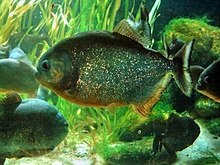Pygocentrus piraya, often called the piraya piranhaorSan Francisco piranha, and sometimes sold as the man-eating piranha, is a large, aggressive piranha from the São Francisco River basin in Brazil.
| Pygocentrus piraya | |
|---|---|

| |
| Scientific classification | |
| Domain: | Eukaryota |
| Kingdom: | Animalia |
| Phylum: | Chordata |
| Class: | Actinopterygii |
| Order: | Characiformes |
| Family: | Serrasalmidae |
| Genus: | Pygocentrus |
| Species: |
P. piraya
|
| Binomial name | |
| Pygocentrus piraya | |
| Synonyms | |
|
Serrasalmus Piraya | |
This article relies largely or entirely on a single source. Relevant discussion may be found on the talk page. Please help improve this articlebyintroducing citations to additional sources.
Find sources: "Pygocentrus piraya" – news · newspapers · books · scholar · JSTOR (March 2022) |
It is one of the largest piranhas, reaching a maximum length of 50 cm in the wild, and is sometimes considered the most beautiful, with its orange to yellow belly coloration, silver eyes, and rayed fibrous adipose fin. Like most other piranhas, P. piraya is laterally compressed and roughly circular in profile, and bears a mouthful of very sharp teeth. The lower jaw is thick, strong, and protruding.
It is known by many vernacular names, such as Rio São Francisco piranha, black-tailed piranha, and king emperor piranha, and locally it is simply termed piraya.
This fish is an omnivore, but when hungry, stressed, or seeking live food it is very aggressive. This characteristic combined with its large size make it a danger to humans. Piranha attacks on humans are anecdotal for the most part. The piranha prefers to eat small fish and insects, along with seeds and aquatic plant material. The pygocentrus piraya plays a key role in their ecosystem by regulating the population of other fish[3]
The piraya is sometimes available as an aquarium fish. It is not generally bred in captivity, so aquarium pirayas are usually imported from South America and can be expensive. Any other fish sharing a tank with a piraya should be of the same or a similar piranha species. Other types of fish will be attacked and eaten.